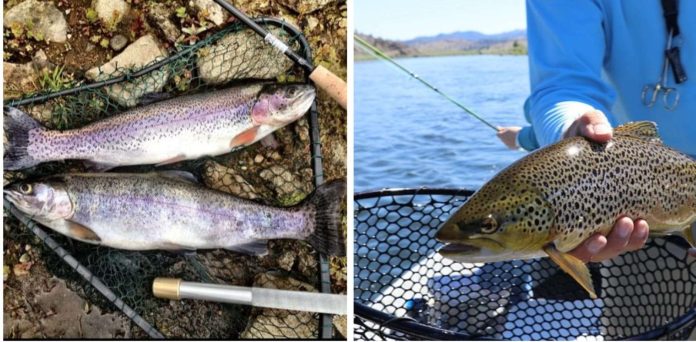Your results can get improved by using the appropriate trout fishing line. While trout can be exciting to catch, they can also be challenging. They consume very few items, have soft, small lips, excellent vision, and thrive in various settings. The fishing line is one of the essential parts of your trout setup. So you might be thinking about what is the best fishing line for trout? Fortunately, there are a variety of appropriate responses, and it all relies on a few elements, like how you’re trout fishing, the size of the fish, and your personal preferences. The short answer below gives the optimum fishing line configuration for trout.
Things to consider
Trout consume a lot of little food, thus throwing, lures, or hooks that weigh at least a quarter of an ounce but sometimes much less is typically necessary. Buying much too heavy a line is one of the worst errors that novice trout fishermen make. It significantly affects your baits’ swimming movement, making throwing challenging and increasing visibility to trout with keen vision. Unless you’re pursuing huge steelhead, lakers, or other enormous trout, the heavy line is usually unnecessary while battling most trout. Most will be 15 inches or smaller, which can get easily handled online, weighing between four to eight pounds; some fishermen even prefer two pounds.
What is the best fishing line for trout – Explained
So, what is the best fishing line for trout? Almost all discussions about fishing lines begin with comparing the many types of lines. Therefore, to save you from reading another lengthy and dull explanation, we will concentrate on the key features of each kind as they relate to trout fishing.
There are three primary varieties of fishing lines available, and each has certain benefits and drawbacks for trout fishing.
Monofilament
Of all fishing lines, Mono is undoubtedly the most versatile. Mostly because fishermen have successfully caught trout using it in every imaginable fashion. It is manageable, affordable, and available in various weights and colors.
However, there are some problems. Casting light spinners with heavy-weight lines is challenging due to Mono’s great memory. According to my observations, mono tangles and twists more than other lines.
The way that Mono handles abuse is also relatively poor. You should routinely check for abrasions while casting near rocks and other structures. Always cut off damaged line portions to avoid losing a fish and the equipment. Mono may get used to casting, fishing with bait, and trolling. We often use monofilament with a 2- 4 pound test with still feeling or spin fishing in streams when targeting trout. When using light gear or tiny gang trolls, start with a 6 to 8-pound test mono based on the type and size of the fish that get pursued.
Fluorocarbon
In terms of invisibility, fluorocarbon is the best to answer what is the best fishing line for trout. Fluoro line practically disappears when submerged in water. Trout stand to gain much from this. The most line-averse fish you’ll ever encounter are trout, so getting a reward requires a cunning strategy.
Fluorocarbon is more resistant to UV rays and abrasion than Mono and is invisible. It also has low memory. Additionally, fluoro is more sensitive to little bites than Mono because it stretches less.
The always go-to line is 4- or 6-pound fluoro when casting light tackle lures on lakes and streams with good visibility. We typically use fluoro as a leader when trolling or casting larger spoons and jigs on such a monofilament or braid the main line.
- Braid
Bass and walleye fisherman have a devoted following regarding braided fishing lines, but trout anglers may feel differently about it.
Braid’s sensitivity is its key benefit. Every tick, bump, and strike gets felt when there is no stretch. Stretchy Mono would make it impossible to detect a nibble while bobbing for lake trout in 90 feet of water. Thus this is helpful.
Braid has an ultra-thin diameter that easily cuts through water and is also highly strong. The low-diameter braid is advantageous for most trolling applications, especially when fishing for trout in the deep ocean without downriggers. The braided line may get lowered deeper with less weight and by smaller divers.
The best weight for fish line
Planning how large the typical fish you’re fishing for is the most crucial factor to consider when choosing the appropriate catching fish line weight, also known as the test. No one solution works for all fish species. Ocean fishermen would use a line that is 50 or 100 pounds test, while trout fishermen may use a 2-pound test. But you can find a straightforward configuration that works for most freshwater fish, including trout. You can typically get away with using a 10 to 30-pound main line and a 2 to 6 pounds leader line.
Does color matter in fishing lines?
Yes, the color of the fishing line does necessarily since some colors are more accessible for fish to perceive than others. It should be transparent or green and not at all colored, like yellow, orange, or any other color. partlythanUsing colored lines help anglers achieve a better presentation since they can see the line above the water thanks to the line’s color.
Final Thought
Trout are enjoyable to catch partly because of their slightly more incredible difficulty than other species. But you must scale back your equipment and pay attention to the little things. Your line is one aspect you shouldn’t ignore. Investing in the appropriate line will help you catch more trout every moment you’re out on the lake. It makes it simpler to throw small lures, detect faint nibbles, and feel bites. More enjoyment will emerge from this. Good luck, and drive carefully!

